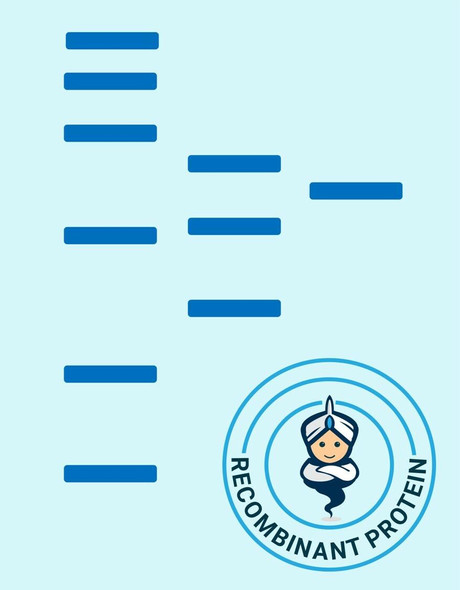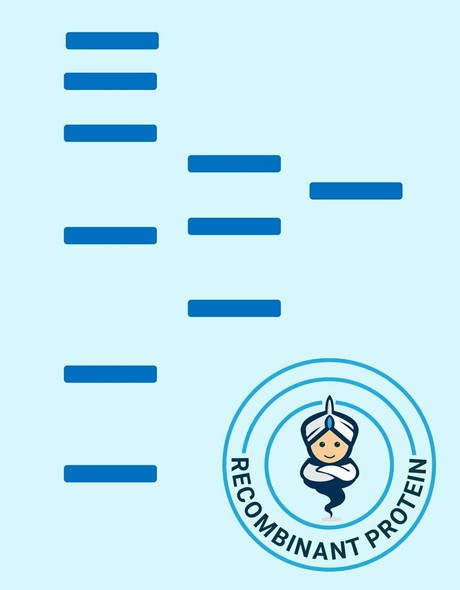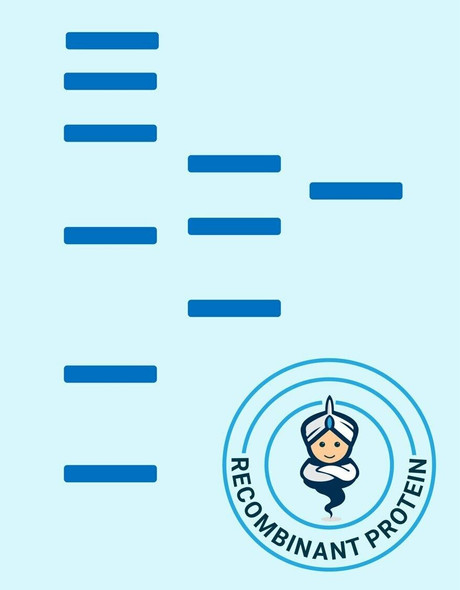Human IL1RL1 Recombinant Protein (RPPB0467)
- SKU:
- RPPB0467
- Product type:
- Recombinant Protein
- Size:
- 10ug
- Species:
- Human
- Target:
- IL1RL1
- Synonyms:
- Interleukin-1 receptor-like 1
- Protein ST2
- IL1RL1
- DER4
- Source:
- Escherichia Coli
- Uniprot:
- Q01638
Description
| Product Name: | Human IL1RL1 Recombinant Protein |
| Product Code: | RPPB0467 |
| Size: | 10µg |
| Species: | Human |
| Target: | IL1RL1 |
| Synonyms: | Interleukin-1 receptor-like 1, Protein ST2, IL1RL1, DER4, ST2, T1, ST2L, ST2V, FIT-1, MGC32623. |
| Source: | Escherichia Coli |
| Physical Appearance: | Sterile Filtered clear solution. |
| Formulation: | IL1RL1 protein solution is supplied in 25mM Sodium Acetate pH 4.8 and 50% glycerol. |
| Stability: | Store at 4°C if entire vial will be used within 2-4 weeks. Store, frozen at -20°C for longer periods of time. Please avoid freeze thaw cycles. |
| Purity: | Greater than 95.0% as determined by SDS-PAGE. |
The IL1RL1 gene is a member of the IL-1 receptor family, encoding a transmembrane protein with a structure similar to IL-1R1. IL1RL1 is a receptor for interleukin-33, its stimulation recruits MYD88, IRAK1, IRAK4, and TRAF6, followed by phosphorylation of MAPK3/ERK1 and/or MAPK1/ERK2, MAPK14, and MAPK8. IL1RL1 may possibly be involved in helper T-cell function. IL1RL1 is highly expressed in kidney, lung, placenta, stomach, skeletal muscle, colon and small intestine. A soluble form of the IL1RL1 is produced from the same gene by alternative splicing and was shown to be expressed in several cell types including fibroblasts and mast cells. Soluble IL1RL1 also acts as a negative regulator of Th2 cytokine production and high levels have been reported in several disease states and conditions including asthma, sepsis and myocardial infarction.Analysis of the similar gene in mouse suggested that the IL1RL1 receptor can be induced by proinflammatory stimuli, and may be involved in the function of helper T cells.
IL1RL1 Human Recombinant produced in E.Coli is a single, non-glycosylated, Polypeptide chain containing 310 amino acids fragment (19-328) corresponding to the soluble IL1RL1 coding sequence, having a molecular weight of 39.5kDa and fused with a 4.5kDa amino-terminal hexahistidine tag. The IL1RL1 is purified by proprietary chromatographic techniques.
| UniProt Protein Function: | IL1RL1: receptor for IL33. Its stimulation recruits MYD88, IRAK1, IRAK4, and TRAF6, followed by phosphorylation of ERK1 and/or ERK2, p38-alpha, and JNK1. Apparently promotes the activation and differentiation of T-helper 2 cells. Belongs to the interleukin-1 receptor family. Highly expressed in kidney, lung, placenta, stomach, skeletal muscle, colon and small intestine. Three isoforms of the human protein are produced by alternative splicing. Isoform A is prevalently expressed in the lung, testis, placenta, stomach and colon. Isoform B is more abundant in the brain, kidney and the liver. Isoform C is not detected in brain, heart, liver, kidney and skeletal muscle. |
| UniProt Protein Details: | Protein type:Membrane protein, integral; Receptor, cytokine Chromosomal Location of Human Ortholog: 2q12 Cellular Component: extracellular matrix; integral to membrane; extracellular region; external side of plasma membrane Molecular Function:hematopoietin/interferon-class (D200-domain) cytokine receptor activity; protein binding; receptor signaling protein activity; interleukin-1 receptor activity Biological Process: negative regulation of T-helper 1 type immune response; negative regulation of interferon-gamma production; immune response; negative regulation of I-kappaB kinase/NF-kappaB cascade; signal transduction; positive regulation of interleukin-5 production; positive regulation of inflammatory response; positive regulation of macrophage activation |
| NCBI Summary: | The protein encoded by this gene is a member of the interleukin 1 receptor family. Studies of the similar gene in mouse suggested that this receptor can be induced by proinflammatory stimuli, and may be involved in the function of helper T cells. This gene, interleukin 1 receptor, type I (IL1R1), interleukin 1 receptor, type II (IL1R2) and interleukin 1 receptor-like 2 (IL1RL2) form a cytokine receptor gene cluster in a region mapped to chromosome 2q12. Alternative splicing of this gene results in multiple transcript variants. [provided by RefSeq, Jul 2008] |
| UniProt Code: | Q01638 |
| NCBI GenInfo Identifier: | 116242527 |
| NCBI Gene ID: | 9173 |
| NCBI Accession: | Q01638.4 |
| UniProt Secondary Accession: | Q01638,Q53TU7, Q8NEJ3, Q9ULV7, Q9UQ44, A8K6B3, B4E0I3 |
| UniProt Related Accession: | Q01638 |
| Molecular Weight: | 23,723 Da |
| NCBI Full Name: | Interleukin-1 receptor-like 1 |
| NCBI Synonym Full Names: | interleukin 1 receptor-like 1 |
| NCBI Official Symbol: | IL1RL1 |
| NCBI Official Synonym Symbols: | T1; ST2; DER4; ST2L; ST2V; FIT-1; IL33R |
| NCBI Protein Information: | interleukin-1 receptor-like 1; growth stimulation-expressed; interleukin 1 receptor-related protein; homolog of mouse growth stimulation-expressed |
| UniProt Protein Name: | Interleukin-1 receptor-like 1 |
| UniProt Synonym Protein Names: | Protein ST2 |
| Protein Family: | Interleukin-1 receptor |
| UniProt Gene Name: | IL1RL1 |
| UniProt Entry Name: | ILRL1_HUMAN |










